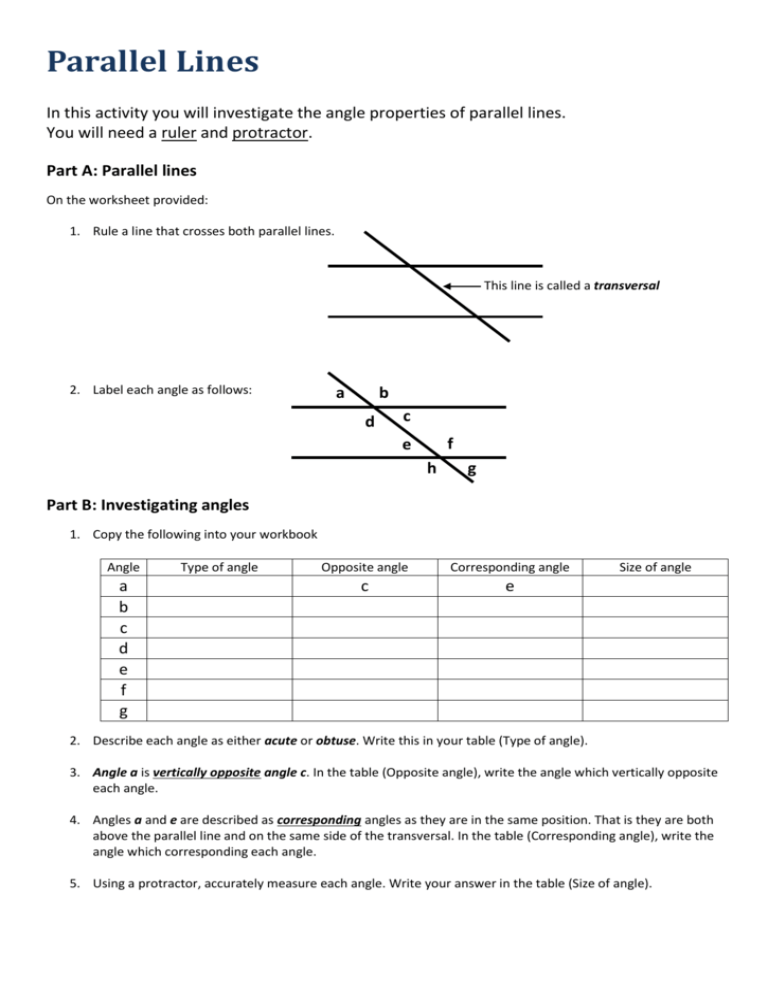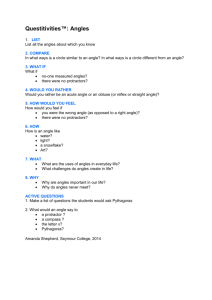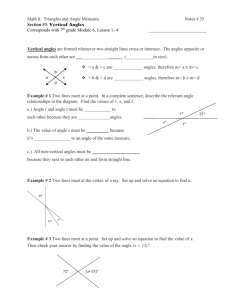Part A: Parallel lines
advertisement

Parallel Lines In this activity you will investigate the angle properties of parallel lines. You will need a ruler and protractor. Part A: Parallel lines On the worksheet provided: 1. Rule a line that crosses both parallel lines. This line is called a transversal 2. Label each angle as follows: a b d c f e h g Part B: Investigating angles 1. Copy the following into your workbook Angle a b c d e f g Type of angle Opposite angle Corresponding angle c e Size of angle 2. Describe each angle as either acute or obtuse. Write this in your table (Type of angle). 3. Angle a is vertically opposite angle c. In the table (Opposite angle), write the angle which vertically opposite each angle. 4. Angles a and e are described as corresponding angles as they are in the same position. That is they are both above the parallel line and on the same side of the transversal. In the table (Corresponding angle), write the angle which corresponding each angle. 5. Using a protractor, accurately measure each angle. Write your answer in the table (Size of angle). Part C: Thinking about it Answer the following questions: 1. 2. 3. 4. 5. Which angles are equal to angle a? Which angles are equal to angle b? What can you say about vertically opposite angles? What can you say about corresponding angles? Angles a and b are adjacent angles (next to each other). They are said to be supplementary angles as they add up to a straight line or 180o. Which other adjacent angles are also supplementary? 6. Angles d and e are described as co-interior angles. Which other pair of angles could also be described as cointerior? 7. What is the sum of angles d and e? (d + e)? 8. What is the sum of the other pair of co-interior angles? 9. Angles d and f are described as alternate angles. Which other pair of angles could also be described as alternate angles? 10. What can you say about the sum of alternate angles? Part D: Conclusion Copy and complete the following statements: Vertically opposite angles are always Corresponding angles are always Adjacent angles always add up to Co-interior angles always add up to . . . . Part E: Is this always true? Investigate whether the conclusions you made are always true by ruling another transversal across your parallel lines and investigating vertically opposite, corresponding, adjacent and co-interior angles. Part F: Glossary Using the online dictionary www.amathsdictionaryforkids.com/dictionary.html , look up the definitions of each of the following terms and copy these into your glossary: Parallel Transversal Supplementary Vertically opposite angles Corresponding Adjacent Interior angle Part G: Exercise 5F Do the following questions from Exercise 5F Parallel and Perpendicular lines. Question 3, 6, 7 & 8 Questions 12,13








